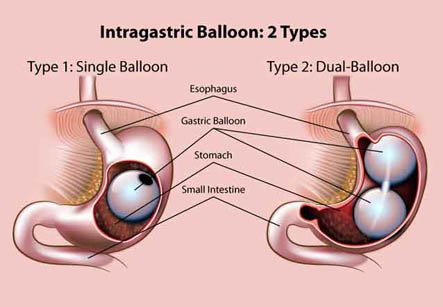Gastric Balloon
Introduction
A Gastric Balloon is a simple gastric surgery device, which is fitted inside the stomach to cause rapid but short term body weight loss. This balloon is made up of soft, expandable, silicone material which is then placed inside the stomach by using a camera inserted through the mouth into the stomach. The empty balloon is filled with sterile saline after insertion. It is a temporary means of reducing weight and it will be usually removed after 6 months.
Overall, it reduces the feelings of hunger and makes the patient feel fuller for longer time, after eating only small meals. This weight loss procedure uses in essence a useful and simple device that can be inserted by a non-surgical procedure and can also be withdrawn easily without much discomfort to the patient.
We have all the information you need about public and private clinics and hospitals that provide weight loss surgeries in Iran, Islamic Republic Of with the best quality and lowest possible prices

Candidate for gastric balloon?
1. Obese persons with an abnormally high BMI.
2. As an aid in obesity surgery, the balloon is sometimes used to create a rapid short term weight loss, to make the weight low enough for further obesity surgery like gastric bypass or gastric banding.
3. In Diabetes mellitus, the short term weight loss can also be used to monitor diabetes mellitus type 2 and determine suitability for the Roux en Y gastric bypass to cure diabetes.
How does a gastric balloon work?
The balloon fills a large portion of the stomach and it reduces the capacity of the stomach to contain food. This creates a feeling of fullness for the patient even with small meals and the patient does not feel continuously hungry.
Intra-Gastric Balloon procedure
A qualified gastroenterologist performs this procedure with the help of an anesthetist and trained nursing staff. An endoscopic camera is inserted in the stomach through the mouth after numbing the back side of the throat by an anesthetic spray. The patient then takes a tiny endoscopic camera inside the throat by swallowing movements, and it will be connected to a video monitor throughout the procedure. When the camera is in the stomach, the surgeon checks for any abnormality.
If no abnormality is found, the surgeon passes the balloon through the mouth and esophagus or the food pipe, into the stomach. Once inside the stomach, the balloon is filled with sterile saline by a small tube attached to the balloon. At this point, the doctor pulls the tube out gently leaving the balloon inside.
The entire procedure may take about 20 minutes on average. After that, the patient is monitored by a trained nursing staff in the recovery area. This is a day care procedure, therefore the patient can go home on the same day of balloon insertion.
How long does a gastric balloon last?
A gastric balloon is typically used for six months, longer periods are not recommended for the patient. Gradually, over time the acidic content in the stomach weakens the balloon material and causes the balloon to deflate on its own. If it has to be used for more than 6 months, a new balloon should be fitted in the stomach.
Antacids are generally prescribed along with the balloon placement for reducing the stomach irritation and chemical damage to the balloon.
How will the gastric balloon be removed?
An endoscopic camera is inserted through the mouth along with a catheter inside the stomach, which is then used to puncture and deflate the gastric balloon. Once deflated, it is held with the help of a grasper and removed from the stomach.
Weight loss due to gastric balloon
a gastric balloon should be considered just an aid to weight loss and not an absolute solution.
It should be made clear to the patient that a gastric balloon should be considered just an aid to weight loss and not an absolute solution. A healthy diet, regular exercise and lifestyle adjustments are pillars to long term and sustainable weight loss results and they must be followed strictly.
Unpleasant effects and considerations
1. Some nausea and vomiting are common for the first few days after the balloon is inserted in the stomach. Medications can help to minimize these side effects.
2. Spontaneous deflation of the balloon: in this case, the surgeon places a colored dye inside the balloon called Methelyene Blue. This helps to diagnose early deflation or leakage by change of color of the urine. Generally, the balloon can pass through the intestine unchanged but in very rare cases, it may have to be removed surgically.
3. At times, weight loss can be minimal or even none at all. This is particularly associated with patients not eating healthy and not modifying bad habits after the procedure. Diet and exercise are very important for positive weight loss results.
4. Uncontrolled weight loss causing adverse effects on health may occur in some cases, therefore regular monitoring will help.